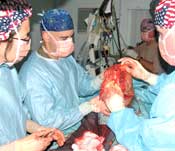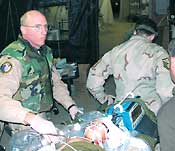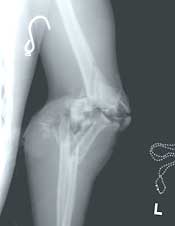Orthopedic surgeons play key role in treating soldiers in Iraq, Afghanistan
Surgeons report some of the biggest challenges are treating hemorrhages and contamination.
 WASHINGTON — Orthopedic surgeons serving in the Operation Iraqi Freedom effort are providing an indispensable service in treating the complex fractures and soft tissue blast injuries associated with combat.
WASHINGTON — Orthopedic surgeons serving in the Operation Iraqi Freedom effort are providing an indispensable service in treating the complex fractures and soft tissue blast injuries associated with combat.
|
|
Surgeons who have served in the region claim they are seeing fewer abdominal/thoracic injuries but more damage to the extremities, as more troops wear body armor consisting of Kevlar vests with ceramic plate inserts for protection.
“Kevlar vests have changed this war, medically speaking. The body is largely protected now. The fatality rate is also lower than that of other wars because many of these soldiers would have died [without the protection], but the incidence of extremity injuries is much higher,” said Col. John V. Ingari, MD, at Tripler Army Medical Center in Honolulu, who moderated a symposium on combat orthopedics at the American Academy of Orthopaedic Surgeons 72nd Annual Meeting.
Approximately 70% of the injuries orthopedic surgeons see while serving in the region are orthopedic-related. “External fixation is the mainstay of our treatment, and the wound vacuum [assisted closure devices] has become a reality for us,” he said.
Ingari and his surgical colleagues have treated more than 210 injured soldiers returned to Tripler Army Medical Center in Hawaii; 62 of them required major surgery. One soldier required surgery on the upper extremity after being hit with a rocket-powered grenade that didn’t explode. “It’s like being hit with a Campbell’s soup can at 200 mph, so it does do some damage,” he said.
Ingari noted that the U.S. military decided seven years ago to use the Hoffmann II external fixator (Stryker Trauma) as the fixator of choice. “It keeps things simple because we use one fixator type, and that has expedited our medical care,” he said.
|
Treating young soldiers who incur blast injuries also requires extensive debridement, he said.
“War injuries are sometimes colonized or infected with bacteria we rarely have seen before. There’s one such bacteria that is ubiquitous to the soil in the [Iraq/Afghanistan] region that we didn’t anticipate, so we spent a lot of time treating contamination and infection,” he said.
Capt. Dana C. Covey, MD, who served as officer-in-charge of Forward Resuscitative Surgery-3 and with Bravo Surgical Company at Camp Fallujah for eight months, said the Navy medical staff cares for Navy and Marine personnel in Iraq and Afghanistan. His group relieved the 82nd Airborne in the Anbar province in March 2004.
While at Camp Fallujah, Covey and his colleagues treated 449 people with combat-related injuries. Improvised explosive devices, rocket-propelled grenades, high-velocity rifles and machine guns, mortars, 122-mm rockets and hand grenades caused these injuries. They also saw another 335 troops who presented with different traumatic injuries, including those received in motor vehicle accidents.
“We use hypotensive resuscitation, or ‘damage-control surgery,’ which involves using fresh whole blood for its clotting factors, meticulous wound management and other techniques to treat many of these patients,” said Covey, who is also chairman of the department of orthopedic surgery at the Naval Medical Center in San Diego. “The benefits of hypotensive resuscitation are to preserve intravascular volume and reduce coagulopathy and hypothermia, which is another common problem.”
Hemorrhaging issues
Because hemorrhaging is a significant problem, Covey and many other surgeons also rely on field dressings, field tourniquets and new technology to foster clotting.
The U.S. Army surgeons may use HemCon (HemCon Inc.), a hemostatic dressing derived from the natural polymer in shrimp shells, he said. The U.S. Marine Corps and U.S. Navy are using QuikClot (Z-Medical), a hemostatic agent with chemically inert material that speeds coagulation of blood, even in large wounds, by absorbing the liquid from blood, thereby concentrating the clotting factors and encouraging rapid clotting to stop the bleeding. However, QuickClot can cause an exothermic reaction that can burn the patient if not used carefully, Covey said.
A newer product, NovoSeven, or recombinant Factor VII, has been approved for use in hemophiliacs and it causes clotting at the site of damage, he said.
Next to the runway at Baghdad International Airport, Air Force medical personnel have set up shop to receive injured Army and Air Force soldiers quickly in the key first hours after an injury. “
Our surgical teams are in combat zones, where there is a constant threat of small arms fire and missile attack,” said Maj. Ky Kobayashi, MD, who served with the 447th Mobile Forward Surgical Team at the airport-based facility consisting of three labs and sheltered tents, as well as an “iso-shelter” housing the operating room.
|
|
Data collection
Each Air Force medical team in Iraq is composed of an orthopedic surgeon, a general surgeon, an emergency room doctor, an anesthesiologist and an operating room nurse, said Kobayashi, who has returned to work at Keesler Medical Center in Mississippi. The team works closely to handle a variety of medical issues, and the orthopedic surgeon plays a leading role in treating the trauma cases.
He said a military trauma database is long overdue.
“I’m sure there are only a few of us here who know what happens to the patients that we treat [in the field],” he said. “Evidence-based validation of our resuscitative and surgical interventions is necessary to better save life and limb on the battlefield.”
Kobayashi and his colleagues started their own database containing data from their operating room logs, along with available medical records and postadmission reports. The database also records patient numbers, information on the injuries sustained and patients’ disposition.
Moving patients
Kobayashi credited the Army “dust off” system for their ability to transport patients in and around Baghdad.
“The tactical and strategic aeromedical evacuation definitely saves lives. We can send critical patients to Germany in less than 24 hours,” he said. In many cases, coalition troops are evacuated by air to other facilities, while Iraqi patients receive in-theater definitive care.
Critical patients may be transported to other facilities by Medevac Humvees or by helicopter. Patients are often airlifted at night to ensure safer travel.
For more information:
- Covey D. The U.S. Navy role and participation in front line care for injured combatants.
- Ingari JV. Introduction to symposium.
- Kobayashi K. Battlefield casualties: Analysis of the 447th Mobile Forward Surgical Team, Baghdad experience. All presented in the symposium, Combat orthopaedics: Ongoing care in the global war on terror. Presented at the American Academy of Orthopaedic Surgeons 72nd Annual Meeting. Feb. 23-27, 2005. Washington.



